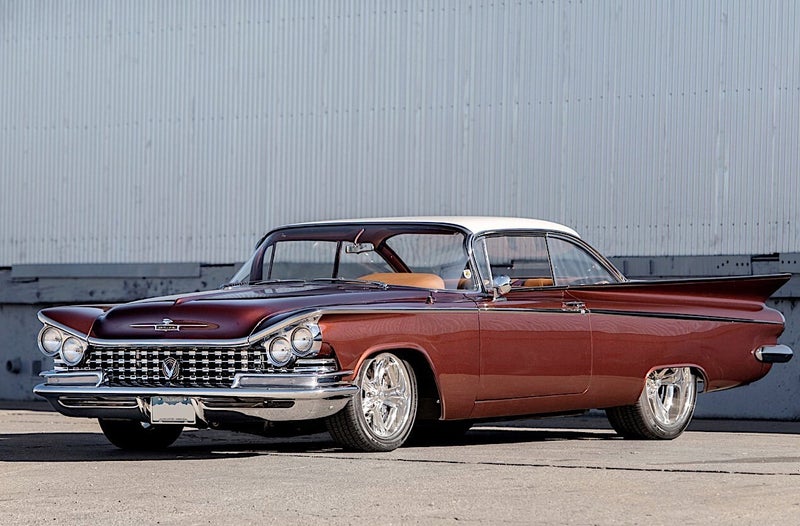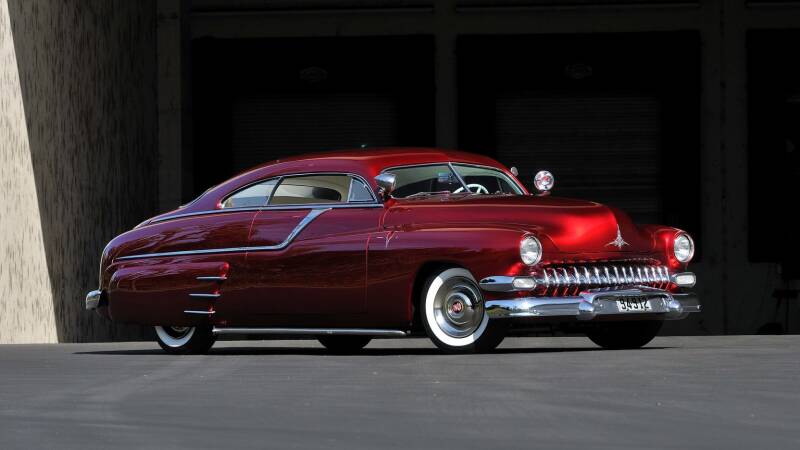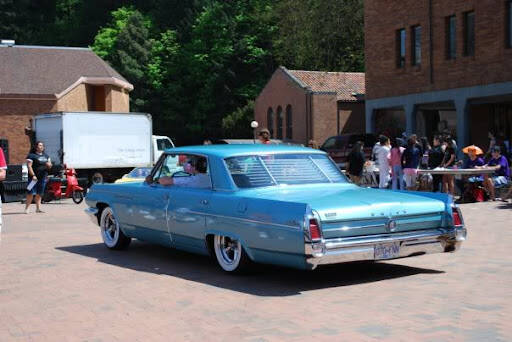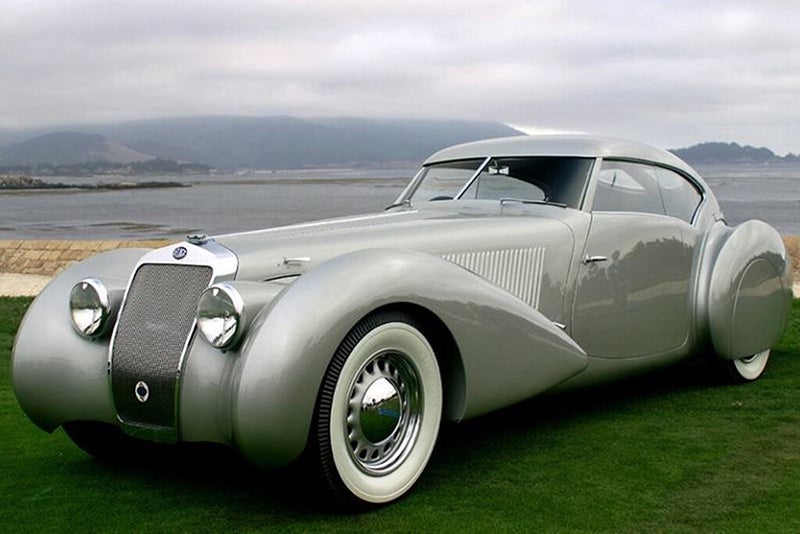


A custom car is a passenger vehicle that has been either substantially altered to improve its performance, often by altering or replacing the engine and transmission; made into a personal "styling" statement, using paint work and aftermarket accessories to make the car look unlike any car as delivered from the factory; or some combination of both. A desire among some automotive enthusiasts in the United States is to push "styling and performance a step beyond the showroom floor - to truly craft an automobile of one's own."
hot rod
Hot rods are typically old, classic, or modern American cars that have been rebuilt or modified with large engines modified for more speed and acceleration. One definition is: "a car that's been stripped down, souped up and made to go much faster." However, there is no definition of the term that is universally accepted and the term is attached to a wide range of vehicles.[4] Most often they are individually designed and constructed using components from many makes of old or new cars, and are most prevalent in the United States and Canada.[4] Many are intended for exhibition rather than for racing or everyday driving.
The origin of the term "hot rod" is unclear. For example, some say that the term "hot" refers to the vehicle's being stolen. Other origin stories include replacing the engine's camshaft or "rod" with a higher performance version. According to the Hot Rod Industry Alliance (HRIA) the term changes in meaning over the years, but "hot rodding has less to do with the vehicle and more to do with an attitude and lifestyle." For example, hot rods were favorites for greasers.
The term has broadened to apply to other items that are modified for a particular purpose, such as "hot-rodded amplifier".

1928 Ford Hot Rod

1934 Chevrolet Outlaw Street Rod

1959 Buick LeSabre Hardtop
muscle car
Muscle car is a description used for a high-performance American car, by some definitions an intermediate sized car fitted with a large displacement V8 engine. Historically they were all rear-wheel drive, but that changed with technological advances.
Although the term was unknown for another fifteen-plus years, General Motors is credited by some as introducing the first "intentional" muscle car in 1949, when it put its 303-cubic-inch (5 l) Rocket V8 from its full-sized luxury car 98 model into the considerably smaller and lighter Oldsmobile 88.[1] The competition between American manufacturers started when Chrysler installed the 331 cu in (5.4 L) Chrysler Hemi engine in the mid-range Chrysler Saratoga in 1951 that was normally installed in the full-sized luxury sedan Chrysler New Yorker. In 1952 Ford's luxury brand Lincoln introduced the 317 cu in (5.2 L) Lincoln Y-Block V8 and the rivalry began, where the Lincoln Capri was entered in the Pan American Road Race in both 1952 and 1953, and taking first and second place in 1954. This was followed by both the Oldsmobile 88 and Chrysler Saratoga being raced in stock form at NASCAR races across the country.
By some accounts, the "muscle car" term proper was originally applied to mid-1960s and early 1970s special editions of mass-production cars which were designed for drag racing, though it shortly entered the general vocabulary through car magazines and automobile marketing and became used generically for "performance"-oriented street cars.
By some period definitions and perceptions, the term muscle car came to connote high performance at budget prices, where extremely powerful engines were put into relatively bare-bones intermediate cars at extremely affordable prices.

1969 Dodge Coronet Super Bee A12 "Six Pack"

1971 Oldsmobile 442

Pontiac GTO (1966 and 1969)
pony car
Pony car is an American car classification for affordable, compact, highly styled coupés or convertibles with a "sporty" or performance-oriented image. Common characteristics include rear-wheel drive, a long hood, a short decklid, a wide range of options to individualize each car and use of mass-produced parts shared with other models.
The popularity of pony cars is largely due to the launch of the Ford Mustang in 1964. Currently produced pony cars are the Ford Mustang, Chevrolet Camaro, and Dodge Challenger.
The first pony car to be released was the Plymouth Barracuda, which went on sale on April 1, 1964 (two weeks before the Ford Mustang). The Barracuda was released as a fastback coupe, based on the platform of the Plymouth Valiant compact car. At the Ford Motor Company, executive Lee Iacocca had commissioned marketing studies which suggested that if a unique-looking sporty car could be offered at an affordable price, it would find many buyers. Therefore Ford continued development of a sporty 2+2 car based on the Ford Falcon platform, leading to the launch of the 1965 Ford Mustang on April 17, 1964.

1970 Barracuda Hardtop Coupe

1964 Ford Mustang

1967 Chevrolet Camaro SS
kustom
Kustoms are modified cars from the 1930s to the early 1960s, done in the customizing styles of that time period. The usage of a "K" for "Kustom" rather than a "C", is believed to have originated with George Barris.
This style generally consists of, but is not limited to, starting with a 2-door coupe and making changes such as lowering the suspension, chopping down the roof line, door handles are also "shaved" as well, and electric solenoids or cables are installed and buttons are installed in hidden locations and used to open the doors. The head and tail lights of a true Kustom may or may not be the original ones manufactured with the car. Some popular swaps would be putting Oldsmobile or Buick headlights in another model for example. Headlights, tail lights, antenna(e) are also subject to term and act called "Frenching", where the object is cut from the body, a "box" in the shape of the item is fabricated and welded into the original hole. The part is then installed back into the "Frenching Pocket" giving it a look of being recessed into the body.
The term kustom is generally used as a signifier that the car was done in the 1950s and early 1960s style as opposed to later more modern styles.

1950 chevrolet

1950 ford

1947 cadillac
lead sled
In automotive usage, a lead sled is a standard production automobile with a body heavily modified in particular ways (see below); especially, though not exclusively, a 1949, 1950 or 1951 model year Ford 'Shoebox' or Mercury Eight car. In the name, "lead" (as in the heavy metal) refers to the heavy weight of the body, and "sled" refers to the lowering of the vehicle, giving these vehicles the appearance that they were "slip sliding" down the highway.
Period auto body repair, by an auto body mechanic used to be achieved through a combination of re-shaping sheet metal using specialist hand tools and the application of molten lead to damaged body panels, fulfilling the role of more modern polyester fillers.
The same techniques were also used in high end low volume car production (coachbuilding) and adopted for aftermarket hot rodding body panel modifications.
Given that lead is toxic, the effective management of health hazards arising from autobody work with this material must include the exposure realms of fumes and dusts. The entire process of removing badges, trim, and doorhandles was referred to as "shaving".

1950 mercury monterey

1940 Series 62 Cadillac

1953 chevrolet
low rider
A lowrider or low rider is a customized car with a lowered body.[1] These customized vehicles are generally individually painted with intricate, colorful designs, rolling on wire-spoke wheels with whitewall tires. Lowrider rims are generally smaller than the original wheels, ranging down to 330 mm. They are also fitted with hydraulic or air bag systems that allow height adjustable suspension, where the vehicle is raised or lowered at the owner's command. Given these specific characteristics, while a lowrider is always a lowered car, a lowered car is not always a lowrider. The term is used to describe a class of vehicle, not simply the height from ground to chassis.
The lowrider car serves no practical purpose. Lowrider car culture began in Los Angeles, California in the mid-to-late 1940s and during the post-war prosperity of the 1950s. Initially, some Mexican-American youths lowered blocks, cut spring coils, z'ed the frames and dropped spindles. The aim of the lowriders is to cruise as slowly as possible, "Low and Slow" being their motto.

1963 chevrolet impala

1964 buick lesabre

1982 buick regal
rat rod
A rat rod, as usually known today, is a custom car with a deliberately worn-down, unfinished appearance, typically lacking paint, showing rust, and made from cheap or cast-off parts. These parts can include non-automotive items that have been repurposed, such as a rifle used as a gear shifter, wrenches as door handles, or hand saws as sun visors. Whether or not so appointed, the rat rod uniquely conveys its builder’s imagination.
The term has also been applied to a style of hot rod or custom car that broadly imitates or exaggerates the early hot rods of the mid-twentieth century, unlike the "traditional" hot rod, which is one built at that time or a close re-creation of one of such.
Originally, rat rods were a counter-reaction to the high-priced "customs" and typical hot rods, many of which were seldom driven and served only a decorative purpose. The rat rod's inception signified a throwback to the hot rods of the earlier days of hot-rod culture—built according to the owner's abilities and with the intention of being driven. Rat rods are meant to loosely imitate, in both form and function, the "traditional" hot rods of the era. Biker, greaser, rockabilly, psychobilly, and punk sub-cultures are often cited as influences that shaped rat rodding.

1930 Ford Model A

1949 Chevrolet 3100

1936 International Harvester pickup
rice burner
Rice burner is a pejorative term originally applied to Japanese motorcycles and which later expanded to include Japanese cars or any East Asian-made vehicles. Variations include rice rocket, referring most often to Japanese superbikes, rice machine, rice grinder or simply ricer.
Riced out is an adjective denigrating a badly customized sports compact car, "usually with oversized or ill-matched exterior appointments". Rice boy is a US derogatory term for the driver or builder of an import-car hot rod. The terms may disparage cars or car enthusiasts as imposters, or wanna-bes, using cheap modifications to imitate appearance of high performance. The term is often defined as offensive or racist stereotyping. In some cases, users of the term assert that it is not offensive or racist, or else treat the term as a humorous, mild insult rather than a racial slur.

199 Honda Civic SI

1995 honda civic

mitsubishi lancer
restomod
Resto-modification, also known as resto-modding, is when "you take an old car and modernize it with an updated engine, suspension, brakes, tires and[/or] electronics. And if you resto-mod the right way, you can revert back to stock at any time." Stock is "A vehicle that has not been modified and is in the same configuration as it came from the factory." Various reasons for performing resto-modifications on vintage cars may include the owner's desire to have either modern conveniences, improvements in vehicle safety or reliability, and/or improvements in street or track-driving performance. Resto-modifications for modern convenience and safety may include adding features such as air conditioning, power windows, power steering, power brakes, seatbelts, or radio/stereo systems that may have not come installed on a vehicle at the time it was originally produced.[9] Upgrades may include newer safety components such as seat belts, brakes or using relays to reduce electric current flowing through light switches. Usability upgrades such as fitting intermittent wipers, an alternator instead of a dynamo, or electronic ignition system instead of contact breaker points ignition system. Emissions upgrades such as hardened valve seats to use standard unleaded fuel, or retrofitted catalytic converters. Upgrades that are easily reversible to the original condition, or were available when the vehicle was current, would be less likely to be controversial. Less acceptable to the classic car market may be major alterations like engine swaps or gearbox transplants, which would be more like hot rodding.

1965 Alfo Romeo Giulia GTA

Eagle E-type

Singer Porsche 911
bosozoku
Bōsōzoku (literally "running-out-of-control (as of a vehicle) tribe") is a Japanese youth subculture associated with customized motorcycles. The first appearance of these types of biker gangs was in the 1950s. Popularity climbed throughout the 1980s and 1990s, peaking at an estimated 42,510 members in 1982. Their numbers dropped dramatically in the 2000s with a reported number of under 7,297 members in 2012. Typical accessories to this uniform are hachimaki, surgical masks, and patches displaying the Japanese Imperial Flag. Bōsōzoku members are known for taking a Japanese Road Bike and adding modifications such as over-sized fairings, lifted handle bars shifted inwards, large seat backs, extravagant paint jobs, and modified mufflers. Bōsōzoku styles take inspiration from choppers, greasers, and Teddy boys.
Bōsōzoku first started as groups of returning World War II veterans. Many veterans were having a hard time readjusting to society after the panic of the war, and the most extreme turned to alternative methods to fuel their excitement. Many turned to custom car making and gang-like activities on city streets to gain an adrenaline fix. They gained many inspirations from American greaser culture and imported western films. This would explain the many similarities between old American biker culture and the bōsōzoku characteristics.



hi riser
Hi-risers, also known as donks and quan-cars, are a type of heavily-customized automobile, typically a full-size, body-on-frame, rear-wheel drive American sedan modified by significantly increasing the vehicle's ground clearance and adding large-diameter wheels with low-profile tires. Depending on the model and style of body, autos customized in this manner can be labeled," "box," or "bubble."
Hi-risers originally grew out of the Dirty South subculture, but the trend has spread across the United States. Vehicles customized in the hi-riser style are distinguished by their over-sized (even disproportionate) wheels, ranging from 20 inches to 30 inches or more in diameter (largest being 50 inch), as well as fanciful custom paint-jobs and expensive audio equipment. Suspension modifications similar to those employed on lifted pickup trucks are made to give adequate clearance for the large wheels. Often the suspension is modified so the front end sits slightly higher than the rear end, giving the car a swaggering appearance. Because of the exaggerated look gained from installing a lifted suspension and enormous wheels, donks are also known as "hi-risers" or "skyscrapers".

1975 Oldsmobile Delta 88 donk

1986 Chevrolet Caprice

1976 Chevrolet Impala
sleeper
A sleeper or Q-car is a car that has high performance and an unassuming exterior.[1][2][3] Sleeper cars are so called because their exterior looks similar or identical to a standard or economy-class car. In some cases the car appears worse due to seeming neglect on the owner's part, typically referred to as "all go and no show". While appearing to be a standard or neglected car, internally they are modified to have higher performance levels. The American nomenclature comes from the term sleeper agent, while the British term derives from the Q-ships used by the Royal Navy.
The 1968 Mercedes-Benz 300SEL 6.3 was a powerful sedan with a subdued exterior. A trend of overtly powerful saloon cars with subtle body modifications is exemplified by the work of Mercedes-AMG and Brabus on unassuming Mercedes saloons. The 1986 Lancia Thema 8.32, fitted with a Ferrari V8 engine, has been described by Road & Track as "one of the weirder sleepers to come out of the 1980s".

Lancia Thema 8.32

volvo T5R

1957 Chrysler 300c
replica
A replica, re-creation, or tribute, is "A vehicle that has been modified to appear like another car or truck entirely, or like a more desirable version of that same vehicle."[1] Replica restorations are often performed by enthusiasts who want to imitate specific rare or famous vehicles, such as one from a particular movie or TV show. One such example is Trey Gee and his 1970 Pontiac LeMans published in High-Performance Pontiac magazine, which has been restored to replicate a much rarer Pontiac GTO Judge of the same year, a car which has recorded "auction sale prices [peaking] at well over $300,000." Trey is quoted in the article saying "'I really wanted a classic GTO, but with the power, ride, and comfort to rival modern cars—a great car to drive. At the same time, I didn't want to heavily modify an original GTO or Judge and put lots of miles on it, because I would feel guilty for depreciating a piece of history, so I decided that a tribute car built as a resto-mod would be my best choice.'"
Some individuals within the auto enthusiast community disapprove of replica restorations due to the prior cases in which some individuals performing said restorations, such as turning a 1967 Pontiac LeMans into a replication of a Pontiac GTO of the same year, a rarer model, and fraudulently selling it advertised as the rarer and more sought after model with the higher price tag.

McLaren F1 based on Porsche Boxster

Bentley Continental based on Chrysler Sebring

Ferrari 348 based on Toyota MR2
concours d' elegance
While the event known as Concours d' Elegance is an "invitation only" show of prestigious automobiles, the term "Concours d'Elegance Ready" Automobiles refers to the highest level of auto restoration. To term a restored car a "Concours d'Elegance Ready Automobile, or, "Concours Ready" for short, doesn't necessarily mean it will be exhibited and judged in Concours d'Elegance Events. The term is rather used to provide a comprehensive understanding of what level of automobile restoration has been completed on a car, or, what level of restoration on a car is underway by a very experienced Master Craftsperson in Automobile Restoration. This highest level of Restoration is distinguished from "Traditional Restoration" because a Concours Ready Car far exceeds the quality of the original manufacturer in its original debut day, because, the high standards set by judges at Concours D'Elegance events worldwide, demand that not a scratch or nick be found on even a single nut or bolt in the car being exhibited, as one example. A Concours d'Elegance level restoration means incredible handcrafting has gone into the lengthy and detailed restorative process, using minimalist filler, as another example of what separates this Arete Level of Restoration, from Traditional Automobile Restoration.

1949 Delahaye 175 S

1937 Delage D8-120 S Pourtout Aero Coupé

1937 Alfa Romeo 8C 2900B Touring Berlinetta
outlaw
The term “Outlaw” relates to the Porsche world. Initially, it was a negative connotation given to Porsche enthusiasts whose modifications were deemed sacrilegious by the purists — but now, it’s a fully embraced subculture in the Porsche community.
There are no specifications that dictate whether a car passes as an Outlaw or not, aside from the pure creativity of those involved in the build. The cars, for the most part, remain somewhat like what would have been factory original, but with subtle modifications inside and out. While tastes vary, many Outlaw aficionados frown upon flashy modifications and want it to look as subtle and underrated as possible. Some think Outlaw cars should look almost stock, to the point where a guy walks up to it and knows it looks a little different, but can't put his finger on why. Yet others want their Porsche to stand out and are willing to go a little crazy in order to achieve that. How the car drives and performs is crucial, and everyone is looking to make their car better to drive through improvements to engines, brakes, suspension, and tires.

Magnus Walker's 277

DP Motorsport 911 RS 3.5 Evolution

Porsche 356 Emory Special
slab
Said to be an acronym for slow, loud, and bangin’, slabs are a type of modified car that originated in the city of Houston. Their looks can be traced to the over-extravagant rides featured in 1970s blaxploitation films and a number of mainstream movies too. Slabs emerged in Houston, Texas’ African American communities in the mid-1980s. More specifically, it emerged in the streets. This was the mid-1980s during the crack era. Some young men were getting relatively wealthy selling drugs, and they used slabs as a way to show off their success, while also using it as an artistic outlet. But in the early 1990s, slabs moved out of that experience and became part of the local hip-hop culture. And that’s when the slab scene really expanded and grew.
A slab is typically an older model, large-bodied, American sedan – Cadillac, Lincoln, Oldsmobile, etc. And it’s embellished or outfitted with various types of body additions, the first and most important one being the rims called “swangas” or “elbows.” Those are those cone-like rims that poke out pretty far. On the trunk, you have what’s called a “fifth wheel,” which is a rim that’s cut in half and enclosed in a fiberglass casing. Also explosive stereo systems that rattle or shake the car and shake the surroundings when listening to rap music.



VIP style
VIP style is a car modification trend that translates from the Romanised Japanese term 'bippu.' It refers to the modification of Japanese luxury automobiles to make them lower and wider in stance, with more aggressive wheels, suspension, and body kits. VIP Style cars are typically large, expensive, rear-wheel drive sedans, although automotive enthusiasts sometimes use other cars such as minivans and kei cars.
VIP cars were once associated with the Yakuza; however, VIP style modifications are now a subset of their own as automotive modifications. As a trend, it differentiates itself from the traditional origins of the term VIP otherwise associated with the concept of a "very important person".
The VIP style has become a loose appropriation of the term perpetuated amongst enthusiasts that goes beyond traditional VIP cars. VIP modifications and their history have often been linked to the Yakuza. By using local manufactured cars with modifications associated with limousines, gangsters could avoid detection by the police and rival gangs.
Cars associated with VIP style modifications usually have common characteristics, such as flashy "deep dish" wheels with low offsets that sit flush with the fenders, exhausts that stick out past the rear bumper, a body kit, glossy paint, and a lowered ride height. It is not uncommon to see significant negative camber on many VIP style cars. Traditional VIP style colours are usually black, white, grey and silver.

Toyota Crown

Lexus LS400

Infiniti Q45




Create Your Own Website With JouwWeb